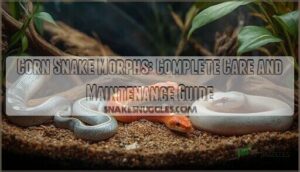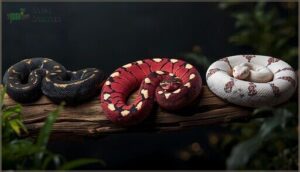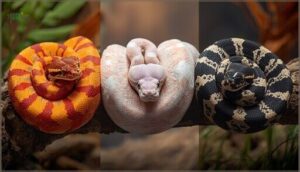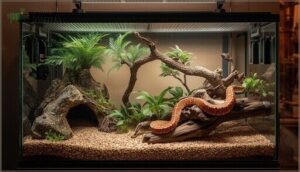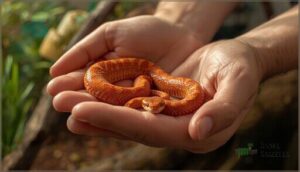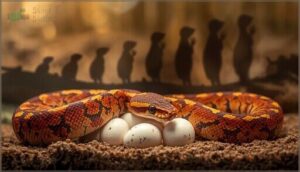This site is supported by our readers. We may earn a commission, at no cost to you, if you purchase through links.
When you pick up a corn snake that gleams like polished pewter instead of the classic orange and red, you’re holding the result of deliberate genetic selection. Over 800 corn snake morphs exist today, bred from roughly 33 genetic strains that alter everything from color intensity to pattern distribution.
While most morphs share core husbandry requirements, some genetic traits—like the light sensitivity in albinos or the neurological quirks in scaleless varieties—demand specific adjustments to keep your snake thriving. Understanding how genetics influence not just appearance but also health vulnerabilities helps you provide targeted care that matches your morph’s unique needs.
Table Of Contents
- Key Takeaways
- What Are Corn Snake Morphs?
- Popular Corn Snake Morph Varieties
- Choosing The Right Corn Snake Morph
- Setting Up a Corn Snake Enclosure
- Maintaining Temperature and Humidity
- Enrichment and Hiding Spots
- Feeding and Diet for Corn Snake Morphs
- Handling and Socializing Your Corn Snake
- Preventing and Managing Health Issues
- Long-Term Care and Breeding Considerations
- Frequently Asked Questions (FAQs)
- Conclusion
Key Takeaways
- Different corn snake morphs may need special care, like reduced light for albinos or extra humidity for certain genetic traits.
- Secure enclosures with locking lids and safe substrates are essential to prevent escapes and support your snake’s health.
- Regular spot-cleaning, proper temperature and humidity control, and routine vet visits help prevent common health problems.
- Buying from reputable breeders with clear genetic records protects against hidden health issues and ensures predictable traits.
What Are Corn Snake Morphs?
If you’ve spent any time browsing corn snakes, you’ve probably noticed they come in a stunning range of colors and patterns—from fiery oranges to ghostly whites.
These variations aren’t just random; they’re called morphs, and they’re the result of selective breeding for specific genetic traits.
Understanding what morphs are and how they work will help you choose the right snake and appreciate the genetics behind your pet’s unique look.
Definition of Morphs
Corn snake morphs are distinct visual variations created by genetic differences that affect coloration patterns and body markings. Think of them as nature’s art gallery—each morph showcases unique genetic traits that set it apart from wild-type snakes.
- Over 800 morphs exist from roughly 33 genetic strains
- Color patterns range from bright reds to silvery lavenders
- Genetic variation produces stripes, motley spots, or diffused patterns
- Breed standards help you identify specific morphs reliably
Understanding the genetics behind these morphs involves studying genetic morph types.
Genetic Basics of Morphs
Understanding how morphs pass from parents to offspring helps you make informed breeding decisions. Gene inheritance follows predictable patterns—recessive traits need two copies to show up, while dominant genes express with just one. The CLCN2 gene controls pattern variations like Motley and Stripe through reduced expression or transposon insertion. Corn snakes boast an impressive variety, with over 800 recognized morphs due to genetic variations.
| Gene Type | Copies Needed | Expression | Example Morphs | Carrier Potential |
|---|---|---|---|---|
| Recessive | Two | Full trait | Amelanistic, Anerythristic | Yes, heterozygous |
| Co-dominant | One or two | Partial or full | Tessera, Palmetto | Intermediate traits |
| Dominant | One | Always visible | (Rare in corns) | Not applicable |
| CLCN2-linked | Varies | Pattern-specific | Motley, Stripe | Gene-dependent |
| Wild-type | Two normal | Standard appearance | Normal, Miami | No mutation |
Mutation rates stay relatively low, but selective breeding accumulates desirable genetic traits over generations.
How Morphs Influence Appearance
Genetic mutations directly reshape your snake’s visual traits—from vivid reds and yellows to altered dorsal patterns. Motley morphs fuse or break standard blotches into linear designs, while Stripe morphs display continuous back stripes and lose the checkered belly entirely.
Pattern complexity ranges from subtle modifications to dramatic transformations, with over 800 recognized morph combinations creating unique scale variations and belly patterns through selective breeding influence.
Through selective breeding, corn snakes now showcase over 800 recognized morph combinations with wildly diverse patterns and scale variations
Popular Corn Snake Morph Varieties
Corn snakes come in a stunning variety of morphs, each with unique colors and patterns that appeal to different keepers. Some morphs are widely available and budget-friendly, while others are exceptionally rare and command premium prices.
Understanding the most popular varieties will help you identify what you’re looking at and make informed decisions when choosing your snake.
Common Color and Pattern Morphs
You’ll encounter a dazzling array of corn snake morphs when choosing your pet. Pattern variations and genetic mutations create distinctive looks across hundreds of commercially available types. Here are the most popular options:
- Albino (Amelanistic) – Bright reds, oranges, and yellows without melanin
- Okeetee – Deep-red saddles with jet-black borders
- Snow – Pink and yellow compound morphs with pink eyes
- Ghost – Pastel lavender and tan hypomelanistic combinations
- Blizzard – Pure white appearance from multiple genetic traits
Rare and Unique Morphs
Some collectors pursue morphs that push genetic boundaries. Over 800 corn snake morphs exist, though they stem from just 28 selected genetic strains. Breeding challenges intensify with multi-trait combinations—morphs like Black Diamond showcase true population rarity. Market value reflects this scarcity, with unique specimens commanding $250–$500. Physical traits distinguish these rarities through striking color and pattern variations you won’t see in standard pet stores.
| Morph Name | Key Genetic Traits | Approximate Price Range |
|---|---|---|
| Black Diamond | Single-gene mutation | $300–$500 |
| Bloodred Pied Sided | Multi-trait recessive | $250–$300 |
| Palmetto | Dominant with limited availability | $400+ |
Identifying Morphs by Traits
How do you reliably identify what you’re looking at? Pattern recognition starts with belly markings—Motley morphs show clear undersides with inverted spots, while Striped morphs display disconnected striping.
Color variations narrow it down further: amelanistic morphs lack black pigment entirely, producing vibrant reds and oranges.
Genetic markers like eye color seal the deal—75% of Snow morphs have distinctive red eyes, making morph identification straightforward with practice.
Choosing The Right Corn Snake Morph
Picking the right corn snake morph isn’t just about choosing the prettiest pattern. You’ll need to think about care differences between morphs, how certain genetics can affect health and behavior, and where you’re getting your snake from.
Let’s walk through what matters most when you’re ready to bring one home.
Morph-Specific Care Considerations
Most corn snake morphs share similar care requirements, but some genetic traits demand specific adjustments. Albino sensitivity to light means you’ll need to reduce UVB exposure and provide extra shade.
Certain morphs from higher humidity regions require humidity adjustments between 65–75%, especially in bioactive setups.
Feeding behaviors may vary slightly between morphs, so watch your snake’s response carefully. Morph-specific care ensures your pet thrives long-term.
Health and Temperament Factors
Not all corn snake morphs behave the same way. Some genetic predispositions can affect both temperament and health, so you need to watch for stress indicators carefully.
- Scaleless and “sunkissed” morphs may show neurological symptoms like stargazing syndrome
- Handling impact varies widely; overhandling increases stress and weakens immune response
- Dysecdysis and respiratory infections are common health issues linked to poor husbandry
- Regular veterinary care helps catch problems early, especially in morphs with genetic vulnerabilities
Selecting From Reputable Breeders
Buying from a breeder with strong marketplace reviews and a solid reputation protects you from genetic surprises down the road. Look for genetic transparency—reputable sources document parentage and het status.
Local breeders often provide better husbandry standards and post-sale support. Check ethical considerations like quarantine protocols and captive-bred stock.
Responsible breeding decisions lead to healthier corn snake morphs with predictable genetic traits.
Setting Up a Corn Snake Enclosure
Your corn snake’s enclosure is the foundation of good health, so getting it right from the start matters. The right setup isn’t complicated, but it does require attention to a few key elements: the size of the tank, security features to prevent escapes, and choosing a substrate that keeps your snake comfortable and clean.
Let’s walk through each of these essentials so you can build a safe, functional home for your pet.
Recommended Enclosure Sizes by Age
Your corn snake’s home needs to grow with them. Hatchlings do well in compact 10-gallon enclosures that help them feel secure. As juveniles reach 12-18 inches, you’ll want to upgrade to a 20-gallon tank.
Adults require a minimum 48″ x 24″ x 24″ enclosure—that’s roughly a 40-75 gallon tank. Vertical space matters too, since corn snake morphs enjoy climbing.
Secure Lids and Escape Prevention
Even the best enclosure size won’t help if your snake escapes. Corn snakes are notorious escape artists—if their head fits through a gap, their whole body follows.
Use at least four locking mechanisms on top-opening lids, and secure front-opening terrariums with sturdy latches. Never leave the habitat open during cleaning, even briefly. Check all clips and locks weekly for wear.
Ideal Substrate Options
After securing your enclosure, choose substrate options for corn snakes that support health and behavior. Aspen shavings work well in drier climates with easy maintenance frequency, while cypress mulch and coconut fiber excel at humidity control. Regional availability may limit some choices.
Aim for substrate depth of three to four inches—this encourages burrowing and naturalistic enrichment. Avoid pine or cedar, as their oils irritate respiratory systems.
Maintaining Temperature and Humidity
Getting the temperature and humidity right isn’t complicated, but it makes all the difference in your corn snake’s health. You’ll need to create a warm side and a cool side in the enclosure so your snake can regulate its body temperature naturally. Let’s break down exactly how to set up and monitor these conditions.
Creating a Proper Temperature Gradient
To keep your corn snake morphs and variations thriving, you’ll need a well-designed temperature gradient that lets your pet regulate its body temperature naturally. Here’s how to set up proper temperature gradient maintenance:
- Establish a basking zone between 85°F and 90°F on one end using heat lamps or ceramic emitters
- Maintain a cool zone at 70°F to 75°F on the opposite side
- Position heat placement equipment with a thermostat covering only one-third of the tank
- Use monitoring tools like digital probes and infrared thermometers to track both zones daily
Proper temperature maintenance directly affects digestive efficiency and overall health impact—your snake’s appetite and activity depend on it.
Nighttime and Daytime Temperature Ranges
Once you’ve established your temperature gradient, understanding the ideal temperatures for day and night becomes critical.
During the day, corn snake morphs and variations need temperatures between 75°F and 85°F to foster normal thermoregulation behavior. At night, let the gradient setup cool to 70°F to 75°F—this natural drop helps healthy circadian rhythms.
Temperatures outside these ranges create serious health impacts, so use monitoring tools like digital thermometers daily.
Monitoring and Adjusting Humidity Levels
How do you keep humidity right for your corn snake morph? Place digital hygrometers centrally in the enclosure to track humidity levels accurately. The ideal humidity range sits between 40% and 60%, but you’ll need to bump it up to 70% during shedding cycles.
Daily misting techniques and substrate choice—like cypress mulch—help maintain proper humidity level maintenance, preventing shedding issues and protecting respiratory health.
Enrichment and Hiding Spots
Your corn snake needs more than just space—it needs places to feel safe and opportunities to explore. A well-designed enclosure with the right hides and enrichment features helps reduce stress and encourages natural behaviors.
Let’s look at the key elements that make your snake’s habitat both secure and stimulating.
Importance of Hides for Security
Your corn snake needs hides to feel safe—without them, stress levels spike and health suffers. Place at least two hides in your enclosure: one in the warm zone and one in the cool area. This setup aids both stress reduction and thermoregulation as your snake moves between temperatures.
Choose hide materials like bark, commercial hideout boxes, or appropriately sized PVC tubes. Proper enclosure design with secure hides promotes wellbeing and natural enrichment behaviors.
Climbing Branches and Environmental Enrichment
Beyond hides, climbing branches transform your enclosure setup into an enriched habitat that mimics natural behavior. Corn snakes demonstrate clear exercise and cognitive benefits when given vertical opportunities—research links enrichment to increased activity and even larger brain volumes.
Assure ideal enclosure design with these essentials:
- Branch texture that provides secure grip
- Secure positioning to prevent falls
- Activity monitoring to assess your snake’s engagement
Safe Tank Decorations
Think of your enclosure decorations as medical equipment—they must be safe first, functional second. Choose non-toxic ceramic or resin hides and untreated wood branches to prevent injury prevention issues. Smooth any sharp edges before placement.
Regular hygiene practices matter: spot-clean weekly and replace porous materials every six months. Durable artificial plants offer climbing enrichment without material toxicity risks, while multiple hideout boxes reduce stress and support long-term health.
Feeding and Diet for Corn Snake Morphs
Feeding your corn snake the right food in the correct amounts is one of the most important parts of keeping it healthy. What you feed and how often depends on your snake’s age and size.
Let’s break down prey types, feeding schedules, and safe techniques to keep your snake thriving.
Appropriate Prey Types and Sizes
You’ll feed your corn snake primarily rodents—specifically, frozen/thawed prey rather than live to prevent injuries. Hatchlings start with pinky mice, then progress through fuzzies and hoppers as they grow. The prey item should match your snake’s mid-body width, never exceeding it.
Occasional prey variety like quail chicks can supplement nutritional needs, though mice remain the staple throughout their life.
Feeding Frequency by Life Stage
Your snake’s age determines how often you’ll reach for that frozen mouse. Hatchlings need meals every 5-7 days to fuel rapid growth, while juveniles shift to weekly feeding as they develop. Subadults extend to 10-12 day intervals, and adults maintain healthy weight on 14-21 day schedules.
Senior snakes or those recovering from illness may require adjusted feeding frequency based on body condition.
Safe Feeding Techniques
Once you’ve nailed down timing, the mechanics of feeding matter just as much. Proper prey size and presentation prevent regurgitation while keeping your snake safe from injury.
- Use frozen-thawed rodents from captive-bred sources warmed to room temperature, avoiding live prey that can bite or scratch.
- Offer meals with metal tongs in the evening, matching your snake’s natural hunting rhythm.
- Skip handling for 48 hours post-feeding to prevent stress-induced regurgitation.
Handling and Socializing Your Corn Snake
Building trust with your corn snake starts with patience and the right approach. Proper handling keeps your snake calm and helps prevent stress-related health issues.
Let’s cover how to introduce handling, what techniques keep both you and your snake safe, and how often you should interact with your pet.
Acclimating New Snakes to Handling
When your new corn snake arrives, patience is essential. Allow 1 to 2 weeks for initial enclosure setup acclimation before attempting any interaction. This gradual acclimation helps reduce stress a lot.
Start with brief 5-minute sessions twice weekly, watching for handling stress signs like rapid tongue flicking or tight coiling. Reducing handling anxiety through this approach builds trust.
Safe interaction duration increases naturally as your corn snake relaxes, making acclimating new corn snakes to handling straightforward with proper technique.
Safe Handling Practices
Once your corn snake shows comfort, proper safe handling practices become key. Reading body language and using secure grip techniques protect both of you during interaction.
Follow these handling techniques:
- Support the full body with gentle pressure, avoiding head or tail restraint
- Keep movements slow and predictable in your handling environment safety setup
- Wash hands before and after—hygiene best practices prevent bacterial transfer
If bite wound care becomes necessary, clean thoroughly with soap and water.
Handling Frequency and Duration
Handling stress signs like rapid tongue flicking or tight coiling tell you when to stop. Post-feeding handling waits 48 hours to prevent regurgitation. Best practices for safe handling of corn snakes mean respecting these limits consistently.
Ideal session length stays around 10 to 15 minutes, once or twice weekly. Individual snake tolerance varies—some corn snakes enjoy frequent interaction, others prefer less.
Preventing and Managing Health Issues
Keeping your corn snake healthy starts with knowing what normal looks and feels like. Once you can spot the early warning signs, you’ll catch problems before they become serious.
Let’s walk through the most important health issues to watch for and how to keep your snake’s environment clean and safe.
Recognizing Signs of Illness
Your corn snake morph can’t tell you when something’s wrong, so you need to watch for early warning signs. Regular observation helps you catch health issues before they escalate.
- Appetite changes: refusal to eat for three weeks or longer
- Shedding problems: incomplete sheds or retained eye caps
- Respiratory signs: wheezing, mucus, or clicking sounds when breathing
- Weight loss: noticeable thinning or weakness
- Stool issues: bloody, mucus-filled, or absent bowel movements
Contact a reptile veterinarian promptly if you notice these symptoms—preventive care saves lives.
Common Health Problems in Corn Snakes
Several health issues appear frequently in captive corn snakes. Respiratory infections affect up to 50% of symptomatic snakes and show wheezing or mucus. Shedding problems impact about 20% annually, often from low humidity.
Parasites like mites occur in roughly 9% of populations. Scale rot develops in 8-12% of cases with poor sanitation.
Obesity now affects up to 18% of pet snakes from overfeeding.
Hygiene and Cleaning Practices
Through daily spot-cleaning and monthly deep disinfection, you’ll prevent most health issues. Use diluted chlorhexidine or veterinary F10SC on surfaces, replacing substrate when soiled. Clean water dishes every other day to stop bacterial growth.
Proper enclosure hygiene reduces respiratory infections and scale rot by 60-70%. This preventive husbandry approach, combined with appropriate substrate choice and shedding support, ensures effective parasite control and disease prevention throughout your corn snake’s life.
Long-Term Care and Breeding Considerations
Corn snakes can live well over a decade with consistent care, and some reach 20 years or more when their needs are met properly. Long-term success depends on maintaining stable husbandry practices and understanding how your snake’s requirements shift as it matures.
If you’re considering breeding, you’ll also need to grasp the basics of morph genetics and reproductive health.
Lifespan and Growth Expectations
Understanding your corn snake’s lifespan helps you prepare for decades of care. Wild vs. captivity makes a big difference—wild corn snakes live 6 to 8 years, while captive snakes can reach 20 years or more with ideal conditions. Here’s what you need to know:
- Hatchlings measure 8 to 12 inches at birth and grow rapidly
- Juveniles reach 20 to 30 inches by 6 months
- Adults achieve full length (2 to 5 feet) around 2 years
- Sexual maturity occurs at 16 to 18 months
Growth rate factors include temperature, diet, and stress levels.
Morphs lifespan remains consistent across color variants—your albino corn snake lives just as long as wild-type snakes. The longest recorded captive corn snake lived 32 years, proving that longterm care quality matters more than genetics.
Key Factors in Long-Term Husbandry
Your corn snake’s longterm care depends on five core husbandry principles. Maintain enclosure security with locking lids and proper enclosure size—adults need 40+ gallons. Establish stable thermal gradients (70-85°F) and temperature gradient monitoring.
Follow consistent feeding schedules: adults every 10-14 days. Practice rigorous habitat hygiene with weekly cleaning.
Schedule routine veterinary care to catch health and wellness issues early, ensuring decades of thriving life.
Morph Genetics and Breeding Tips
Breeding corn snakes demands understanding morph inheritance—recessive traits like Amelanistic need two copies, while Palmetto shows incomplete dominance. Before making breeding decisions and morph genetics choices, consider these essentials:
- Induce breeding brumation at 60-65°F for 8-10 weeks to trigger reproductive cycles
- Use genetic testing to confirm corn snake morph traits and prevent defects
- Provide careful hatchling care with separate housing and feeding monitoring
Emerging morphs expand possibilities as genetic basics reveal new mutations annually.
Frequently Asked Questions (FAQs)
Can corn snakes recognize their owners scent?
Research shows corn snakes can distinguish familiar from unfamiliar human scents—but only when housed in enriched environments.
Environmental complexity enhances their olfactory capabilities, potentially leading to calmer behavioral responses during safe handling sessions.
Do different morphs have different activity levels?
You won’t find morph activity differences tied to genetic traits. Snake behavior and activity patterns depend more on environmental effects and individual corn snake characteristics than morph type.
Activity level shifts with age, enclosure setup, and health—not coloration.
How often should water bowls be changed?
Think of your snake’s water bowl as a lifeline—fresh water daily is essential. Good water quality and weekly bowl cleaning help prevent illness, support hydration needs, and maintain proper humidity. Prioritize water maintenance for best corn snake health.
What signs indicate a corn snake is stressed?
Watch for behavioral stressors like frantic escape, defensive posturing, or refusal to eat. Physical symptoms include regurgitation and shedding issues.
Environmental factors—improper temperature, low humidity, lack of hides—plus physiological signs like heavy breathing signal stress in corn snake health.
Are corn snakes better kept alone or together?
Like islands in a stream, corn snakes thrive best alone. Solitary vs. Social instincts mean cohabitation stressors, injury risks, and disease transmission outweigh any benefit.
Husbandry challenges multiply, regardless of morphs or genetic traits, making solo housing safest for snake behavior.
Conclusion
When Jamie noticed her albino corn snake squinting under bright lights, she adjusted the enclosure’s bulbs and added more hides—simple changes that made a world of difference. This kind of attentive corn snake morphs care and maintenance ensures each morph thrives, no matter its genetic quirks.
By tuning into your snake’s unique signals and needs, you’re not just keeping a pet alive—you’re helping it flourish. Every adjustment you make is a step toward a healthier, happier reptile companion.
- https://www.addtoany.com/share/
- https://image.petmd.com/files/2024-12/1730300-24-10-PMD-CornSnakeCareSheet.pdf?VersionId=C85M2VWn84MucQ1nerMeMYFQ3gfu0JZS?utm_source=petmd.com&utm_campaign=caresheet&utm_medium=PDF
- https://www.technologynetworks.com/genomics/news/single-gene-controls-the-many-patterns-of-snake-skin-398891
- https://a-z-animals.com/blog/corn-snake-morphs-the-complete-list/
- https://djlexotics.co.uk/quick-guide-to-corn-snake-morphs/

